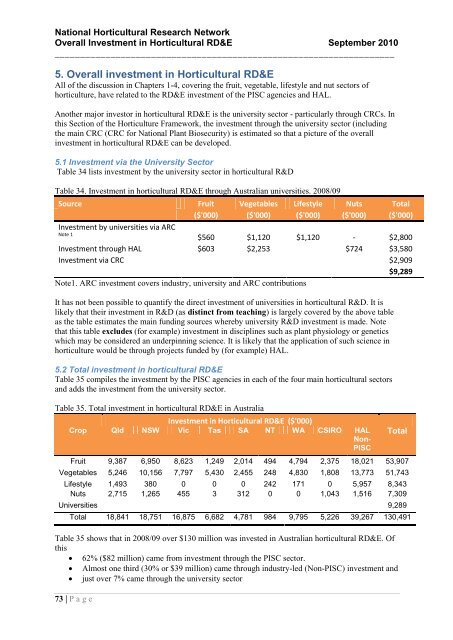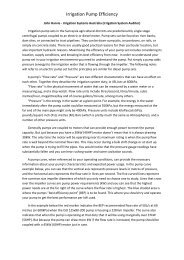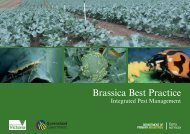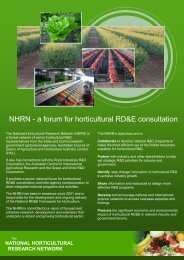National Horticultural Research Network - Horticulture Industry ...
National Horticultural Research Network - Horticulture Industry ...
National Horticultural Research Network - Horticulture Industry ...
You also want an ePaper? Increase the reach of your titles
YUMPU automatically turns print PDFs into web optimized ePapers that Google loves.
<strong>National</strong> <strong>Horticultural</strong> <strong>Research</strong> <strong>Network</strong><br />
Overall Investment in <strong>Horticultural</strong> RD&E September 2010<br />
___________________________________________________________________<br />
5. Overall investment in <strong>Horticultural</strong> RD&E<br />
All of the discussion in Chapters 1-4, covering the fruit, vegetable, lifestyle and nut sectors of<br />
horticulture, have related to the RD&E investment of the PISC agencies and HAL.<br />
Another major investor in horticultural RD&E is the university sector - particularly through CRCs. In<br />
this Section of the <strong>Horticulture</strong> Framework, the investment through the university sector (including<br />
the main CRC (CRC for <strong>National</strong> Plant Biosecurity) is estimated so that a picture of the overall<br />
investment in horticultural RD&E can be developed.<br />
5.1 Investment via the University Sector<br />
Table 34 lists investment by the university sector in horticultural R&D<br />
Table 34. Investment in horticultural RD&E through Australian universities. 2008/09<br />
Source Fruit Vegetables Lifestyle Nuts Total<br />
($'000) ($'000) ($'000) ($'000) ($'000)<br />
Investment by universities via ARC<br />
Note 1<br />
$560 $1,120 $1,120 - $2,800<br />
Investment through HAL $603 $2,253 $724 $3,580<br />
Investment via CRC $2,909<br />
$9,289<br />
Note1. ARC investment covers industry, university and ARC contributions<br />
It has not been possible to quantify the direct investment of universities in horticultural R&D. It is<br />
likely that their investment in R&D (as distinct from teaching) is largely covered by the above table<br />
as the table estimates the main funding sources whereby university R&D investment is made. Note<br />
that this table excludes (for example) investment in disciplines such as plant physiology or genetics<br />
which may be considered an underpinning science. It is likely that the application of such science in<br />
horticulture would be through projects funded by (for example) HAL.<br />
5.2 Total investment in horticultural RD&E<br />
Table 35 compiles the investment by the PISC agencies in each of the four main horticultural sectors<br />
and adds the investment from the university sector.<br />
Table 35. Total investment in horticultural RD&E in Australia<br />
Investment in <strong>Horticultural</strong> RD&E ($'000)<br />
Crop Qld NSW Vic Tas SA NT WA CSIRO HAL<br />
Non-<br />
PISC<br />
73 | P a g e<br />
Total<br />
Fruit 9,387 6,950 8,623 1,249 2,014 494 4,794 2,375 18,021 53,907<br />
Vegetables 5,246 10,156 7,797 5,430 2,455 248 4,830 1,808 13,773 51,743<br />
Lifestyle 1,493 380 0 0 0 242 171 0 5,957 8,343<br />
Nuts 2,715 1,265 455 3 312 0 0 1,043 1,516 7,309<br />
Universities 9,289<br />
Total 18,841 18,751 16,875 6,682 4,781 984 9,795 5,226 39,267 130,491<br />
Table 35 shows that in 2008/09 over $130 million was invested in Australian horticultural RD&E. Of<br />
this<br />
62% ($82 million) came from investment through the PISC sector.<br />
Almost one third (30% or $39 million) came through industry-led (Non-PISC) investment and<br />
just over 7% came through the university sector






